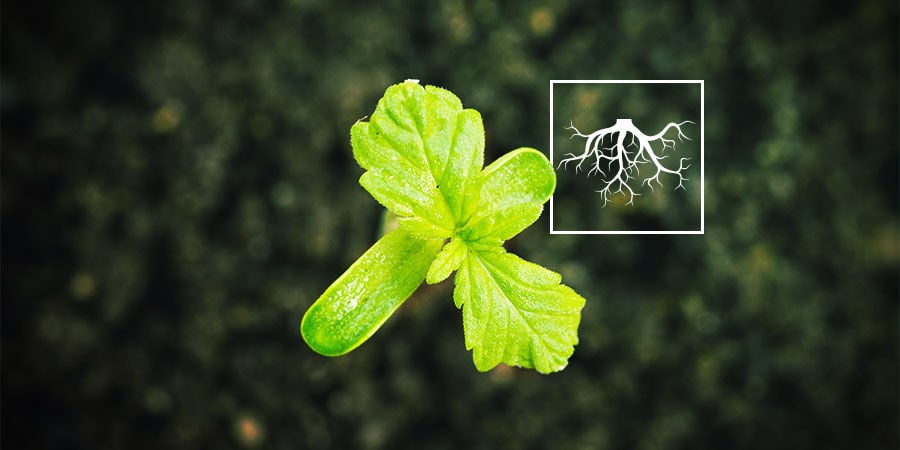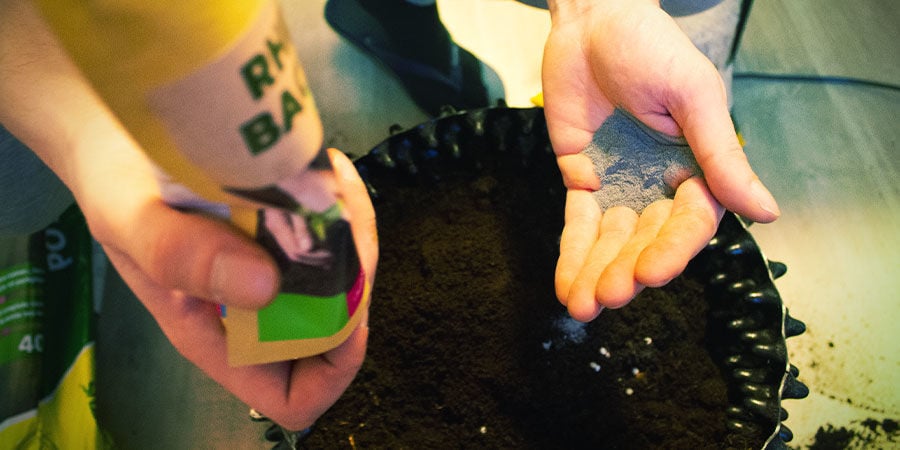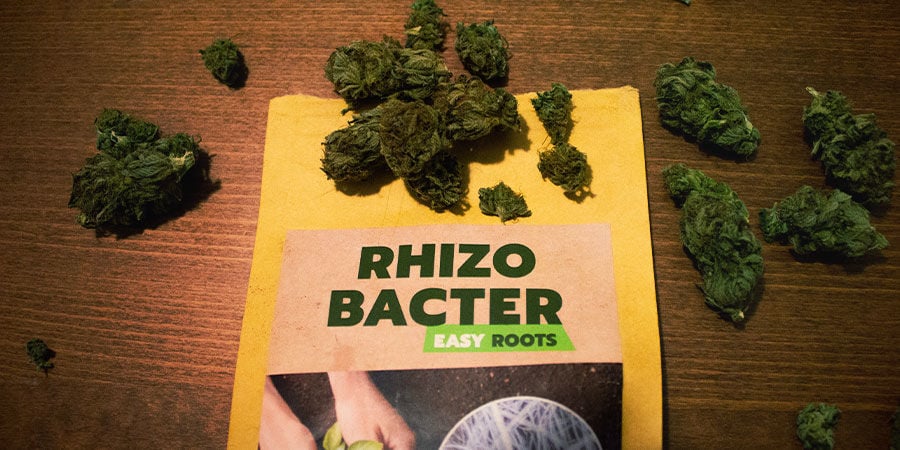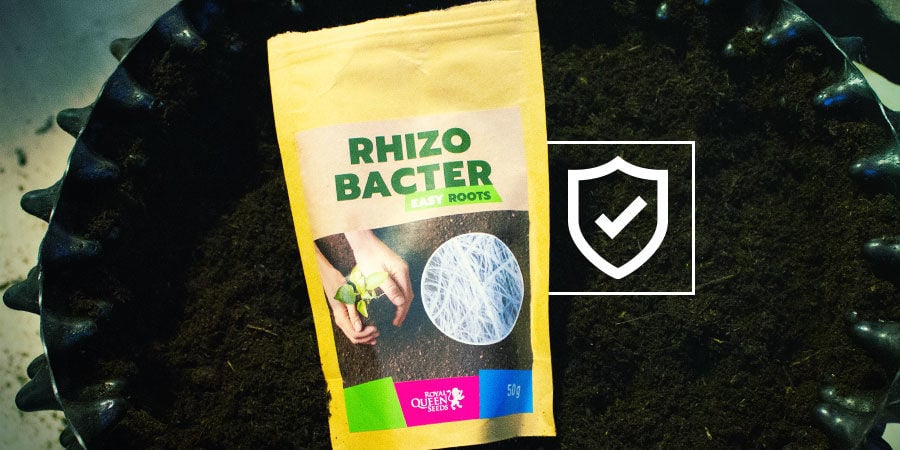How Rhizobacteria Can Promote Cannabis Growth
Cannabis growers often associate bacteria with plant diseases. However, some forms of these microbes dramatically improve plant health and performance. Plant growth-promoting rhizobacteria enhance almost every aspect of cannabis plant physiology, from nutrient uptake and pathogen defence to cannabinoid levels and drought resistance.
Far from a lifeless substance, soil contains millions of microorganisms. While some of these small critters are a threat to the cannabis plant, many of them form alliances with the roots and boost plant growth, vitality, and yields.
Various species of bacteria, fungi, and nematodes patrol the rhizosphere—the slither of soil that surrounds cannabis roots. Although we often associate these microbes with decomposition and decay, many of them actively promote growth.
Cannabis plants are innately intelligent. They appear static to the human eye, but, in reality, they are constantly moving and have a lot of control over their environment. The herb essentially “farms” microbes in the soil. By releasing sugars into the rhizosphere, it attracts beneficial species of fungi and bacteria. In return for these tasty carbohydrates, the microbes mine the soil for nutrients and release growth-promoting plant hormones.
Plant growth-promoting rhizobacteria (PGPR) are soil microbes that help to enhance cannabis cultivation. Learn how to harness these tiny members of the rhizosphere to achieve the biggest possible harvests.
What Are Cannabis Plant Growth-Promoting Rhizobacteria (PGPR)?

Plant growth-promoting rhizobacteria is a term that includes several species of soil bacteria that enhance cannabis plant health. The term “rhizo” relates to “roots”, referring to the location where these species choose to reside.
What attracts PGPR to the roots? Compared to the bulk of the soil, the rhizosphere offers a rich source of nutrients that microorganisms are drawn to. Known as exudates, these sugar molecules are released by cannabis plants to attract beneficial microbes.
Species of PGPR are divided into two main groups: symbiotic species and free-living species.
Symbiotic species live inside plant tissue, where they swap beneficial chemicals with plant cells directly. Some species live in the space between plant cells, whereas others penetrate the cells and live inside of them. Others take things a step further by merging their biology with the plant, forming unique structures made of both plant and bacterial parts.
In contrast, free-living rhizobacteria exist on the outside of roots, where they work to increase yields and protect plants from the stresses of flooding and disease.
Free-living species colonise the outside of cannabis roots. They form patches of communities that cover anywhere between 15–40% of the root surface, clinging to root hairs and the gaps between cells. In the presence of enough nutrients, they cover the entire root surface and form a thick layer of bacteria.
What Are the Benefits of Rhizobacteria for Cannabis Growing?
Plant growth-promoting rhizobacteria boost cannabis plants in several ways. They help to enhance fertilisation, stimulate root growth, minimise plant stress, and even clean up the soil. Rhizobacteria also give cannabis plants a helping hand by defending against disease and assisting them in competing for nutrients.
How Do Rhizobacteria Promote Cannabis Growth?
Growers can use PGPR to enhance the growth of their plants. Just as cultivators use different nutrients, training techniques, and lights in an attempt to boost yields, influencing the rhizosphere produces similar results. Some of the key ways in which rhizobacteria help to promote plant growth include:
-
Growth hormones: PGPR produce several plant hormones that stimulate plant growth. These molecules drive plant development by promoting cell division and cell growth.
-
Nutrient uptake: Rhizobacteria enhance the ability of cannabis plants to uptake nutrients. The plant relies on a fine balance of macro- and micronutrients to fuel growth, drive photosynthesis, and make other metabolic processes possible.
-
Security: These helpful microbes also enable optimal plant growth through their “security services”. By preventing diseases from attacking the roots, they put an end to any attack that might slow down growth and threaten yields.
-
Flower quality: Cannabinoids and terpenes make up the prized molecules within cannabis buds. By influencing nutrient movement and stress control, rhizobacteria increase these compounds and the overall holistic and recreational quality of cannabis flowers.
How Do Rhizobacteria Protect Cannabis Plants?
Although kind to cannabis, PGPR wage war against other species. By fighting other microbes for resource dominance, they help cannabis plants to stay healthy and strong. Aside from fending off living organisms, they also embolden plants against the elements and adverse weather conditions.
Rhizobacteria are truly invested in the health of their host cannabis plant, as it secures them a steady source of food and shelter. In return, they offer protection against various threats. Here's how PGPR protect your weed plants:
-
Produce antibiotics: Not all bacteria in the rhizosphere work well with cannabis. Many species pose a threat to the roots—perhaps the most vital aspect of the entire plant’s anatomy. By manufacturing antibiotic compounds, PGPR kill off the bad guys.
-
They lead plants into battle: As well as producing their own pathogen-killing molecules, rhizobacteria prompt plants to produce their own. By triggering a state of systemic resistance, they signal the cannabis plant to produce its own metabolites designed to fight off pathogens and parasites.
-
Environmental defence: Cannabis plants produce the best results when treated to a stable environment. Sudden extremes, including surges in temperature, droughts, and floods, can negatively impact cannabis, damage plants, and stunt growth. Rhizobacteria increase tolerance and resilience in plants and help them deal with these threats much better.
-
Powdery mildew: This fungal disease plagues growing operations every year, resulting in contaminated flowers. PGPR defend against this crop-destroying fungus.
How and When to Apply Rhizobacteria?

Growers can protect their crop and enhance yields by using PGPR to inoculate their plants. Farmers across the world are starting to use rhizobacteria as a biofertiliser to replace conventional pesticides and chemical fertilisers.
Cultivators can inoculate their plants at several stages throughout the growing cycle. Inoculating seeds with cannabis-compatible rhizobacteria will give your seedlings the best start in life. Simply add around 1g of rhizobacteria into the hole when sowing seeds.
If you've already started growing and want to take advantage of these microorganisms, use the same product to make a soil drench to inoculate the root system. Thoroughly mix 1g of rhizobacteria per litre of water. Apply this formula once every 21 days to keep the rhizosphere thriving with beneficial life.
You can also include rhizobacteria in your transplanting strategy to help plants recover from the stress faster. Sprinkle 1g into the hole before introducing your plant to its new home.
-
 8 min
1 March 2021
How To Increase Cannabis Yields With Root Pru
Growers usually give lots of attention to their cannabis plants, yet the roots are often ignored. Find out how root pruning can benefit the growth, health, and yield of your cannabis plants.
8 min
1 March 2021
How To Increase Cannabis Yields With Root Pru
Growers usually give lots of attention to their cannabis plants, yet the roots are often ignored. Find out how root pruning can benefit the growth, health, and yield of your cannabis plants.
-
 3 min
14 April 2020
Increasing Cannabis Yields With Mycorrhizae
Mycorrhizae are soil superheroes that can make your plants stronger and healthier. Read on to find out more about mycorrhizal fungi and how they can boost your cannabis crops.
3 min
14 April 2020
Increasing Cannabis Yields With Mycorrhizae
Mycorrhizae are soil superheroes that can make your plants stronger and healthier. Read on to find out more about mycorrhizal fungi and how they can boost your cannabis crops.
-
 4 min
31 December 2018
What's The Difference: Synthetic Vs. Natural Fertilizer
Synthetic vs organic fertiliser is a heavily debated topic when it comes to growing cannabis. So let’s take a look at the advantages and disadvantages of each.
4 min
31 December 2018
What's The Difference: Synthetic Vs. Natural Fertilizer
Synthetic vs organic fertiliser is a heavily debated topic when it comes to growing cannabis. So let’s take a look at the advantages and disadvantages of each.
-
 4 min
10 April 2018
5 Ways To Increase Cannabis Yields
Increasing cannabis yields is of paramount importantance to all growers. With our 5 simple methods even tiny gardens of just one or two cannabis plants can produce a heavy harvest.
4 min
10 April 2018
5 Ways To Increase Cannabis Yields
Increasing cannabis yields is of paramount importantance to all growers. With our 5 simple methods even tiny gardens of just one or two cannabis plants can produce a heavy harvest.













 United States
United States













